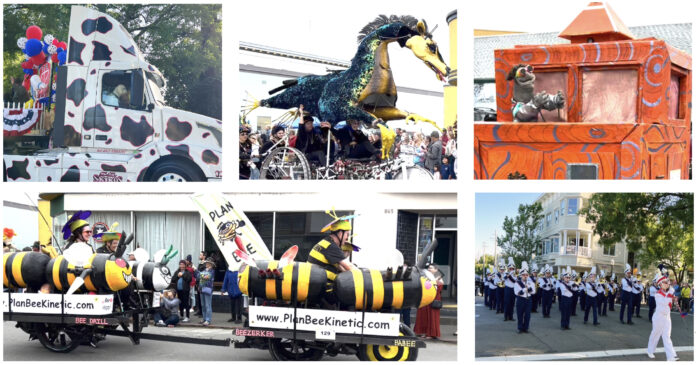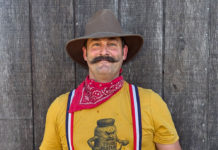It’s Memorial Day weekend, the kick-off to summer in Healdsburg with the Future Farmers of America Twilight Parade featured in pictures with a strutting majorette leading a band and a dog co-piloting an 18-wheeler. The band followed vintage cars occupied by Brad Petersen, President of the Healdsburg Future Farmers of America County Fair, and Emma Hernandez—FFA Sweetheart. Healdsburg’s Kiwanis Club also led the parade, celebrating their 100th anniversary.
It seemed to me that this year’s FFA parade displayed more enthusiasm. Maybe that was pent-up from a long, anti-social/semi-social pandemic experience? Maybe it’s this year’s rising tide of social activities getting everyone in Healdsburg into the spirit? Whatever it might be, it was terrific to see children and adults participate with joy.
Another kind of parade, in fact a race, took place in Arcata this weekend (pictures on the right). It’s called the Kinetic Grand Championship, also known as Kinetic Sculpture racing. It began in 1969 with a two-block dash down Main Street. It’s evolved into a three-day race covering 40 miles beginning on land, moving to sand dunes, then into Humboldt Bay, then across the Eel River and finally finishing—if the ‘Kinetinauts’ make it—on land. The competing vehicles are all-terrain, human-powered mobile sculptures. They are kooky and quirky. Similar to Burning Man art vehicles; think Soggy Man, errrr He/She/Him/Her, Humboldt County.
Whatever your jam, parades are a time to gather and celebrate, as well as to honor those who gave their lives and their service for our freedom to celebrate Memorial Day.
Fun facts: “I Love a Parade” was written by Harold Arlen and Ted Koehlor in 1932. Harry Richman was the singer. He previously had a hit with Irving Berlin’s “Puttin’ on the Ritz.” These songs came out of “Tin Pan Alley,” a real place in New York City, on 28th Street between Broadway and Fifth Avenue. Music publishing houses, some as small as a big closet with a piano, launched America’s music revolution, moving from religious to popular music. Post-Civil War, Americans reportedly purchased 25,000 pianos a year. With about 4% of American households owning a piano, music publishing—especially of popular short tunes—became big business. In 1891, the smash hit “After the Ball” reportedly grossed $25,000 per week for the author/publisher.










We enjoy the happiness of the children in the parade. The loud off-key Mariachi bands, not so much.